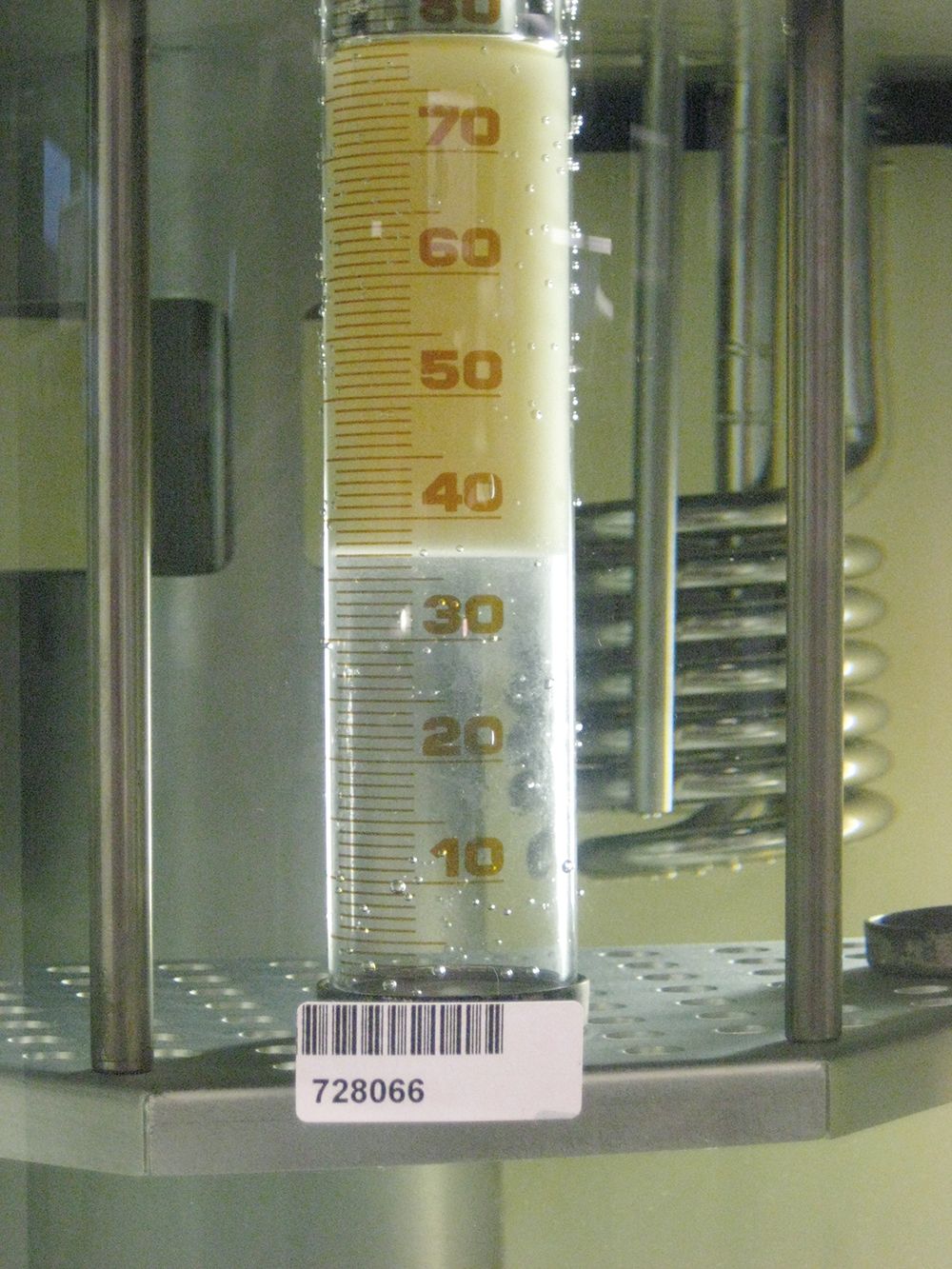Water separability
Usually, water with a density of about 1,000 kg/m³ separates quickly from oil, which is much lighter with a density of 880 to 940 kg/m³, depending on viscosity and oil type. However, separation can be impaired by additives and impurities. In most applications, rapid separation of the oil from the water is desirable, and the oils should behave in a demulsifying manner. But the opposite effect can also be beneficial. Some lubricants, such as hydraulic oils of category HLP-D, are not intended to be demulsifying, but dispersing and detergent. They must bind any moisture that may have penetrated in a finely distributed manner and keep it in suspension.
In order to be able to optimally assess the desired effect of an oil in each case, the water separability , the behavior of mineral oil with respect to contamination with water, is determined using two different methods.
Table of contents
Demulsifying oils
The water separability after steam treatment according to DIN 51589 is based on the behavior of water in steam turbine oils. In steam turbines, rapid separation of oil and water is critical to the survival of the sliding bearings of large power plant turbines. For oils from hydraulic systems and industrial gearboxes, this method, which is presented on our homepage under "Test methods", is only of limited use. The question here is how much condensate separates from the oil. In contrast to steaming the oil, DIN ISO 6614 uses the so-called Herschel test to specify how quickly oil separates from the water finely dispersed by high stirring speed. Dissolved water in the form of condensate is always present in small quantities in the fresh oil (20 to 600 ppm). In used oils it can be found in the form of condensate in almost any industrial or hydraulic oil in small quantities (usually less than 300 ppm). Intensive intermittent operation of equipment causes oil-filled systems to breathe.
Rule of thumb: 200 liters of oil expand by 7 liters when heated by 50°C or decrease in volume by about 7 liters when cooled. Volume compensation takes place via breathing nozzles or "breathers". Condensate is formed due to the moist air that has penetrated during breathing.
However, larger quantities of water can also enter the system in the event of leaks, e.g. in the cooling circuit or during machine cleaning with high-pressure cleaners.
In the case of oils in hydraulic systems or oil circulation systems, the excess water should separate quickly from the oil so that it can be drawn off at the lowest point of the tank. The standard for hydraulic oils DIN 51524 of TYPE HLP specifies a water separability of max. 30 minutes. At the latest after this time, complete 2-phase separation should be detected. Oils in circulation systems of paper machines and calenders must also separate the water as quickly as possible so that it can be completely removed from the oil in a short time by separators. The water must not be kept finely dispersed in suspension, as this can lead to corrosion (rust), cavitation or galling.
Dispersing oils
In contrast, however, there are applications where small amounts of water should not separate from the oil. They must be kept in suspension until they are completely removed from the system via filters or during the next oil change. Most mobile hydraulic systems of excavators and other earthmoving machines, but also the hydraulic systems of machine tools, are therefore predominantly operated with hydraulic oils of type HLP-D (engine oils SAE 10W or 20W-20 also fall into this group). They have a relatively poor demulsifying capacity and have a dispersing effect.
The test method
To test the behavior of such oils against water, the water separability is determined according to DIN ISO 6614. For the test, 40 ml of distilled water and 40 ml of the oil are heated to 50°C respectively. The filled measuring cylinder is immersed in a heat bath at a constant temperature. The two liquids are intensively mixed for five minutes with a large-area stirring blade moved by a motor at 1,500 revolutions in the 1:1 oil-water mixture. The result is a uniformly cloudy and opaque-looking, unstable emulsion. After mixing, the stirring blade is removed from the milky emulsion. In the stationary sample, segregation starts due to gravity. Water settles to the bottom, oil floats on the top phase. At intervals of five minutes each, the volumes of water, oil and the intervening emulsion phase are measured. The appearance of the three individual phases is described. This measurement of volumes is continued until the volume of the emulsion layer lying between the oil and water is less than 3 ml. The test is stopped after one hour if the emulsion content has not reached 3 ml by then.
The indication of the result is usually numerical. Here is an example:
In addition, the appearance of the three layers and their interfaces can be specified as a letter code according to the following scheme:
| Oil: | a) clear |
| b) turbid | |
| c) cloudy or milky | |
| Water: | a) clear |
| b) emulsified or bubbly or both | |
| c) turbid | |
| d) cloudy or milky | |
| Emulsion: | a) loose and emulsified |
| b) cloudy or milky | |
| c) smooth | |
| Layers: | k) well separated, sharp |
l) poorly separated, bubbles | |
| m) poorly separated, emulsified |
OELCHECK has additionally visualized the test progress and the test end. A camera is used to photograph the test cylinder, because a picture says more than the above number and letter codes.




